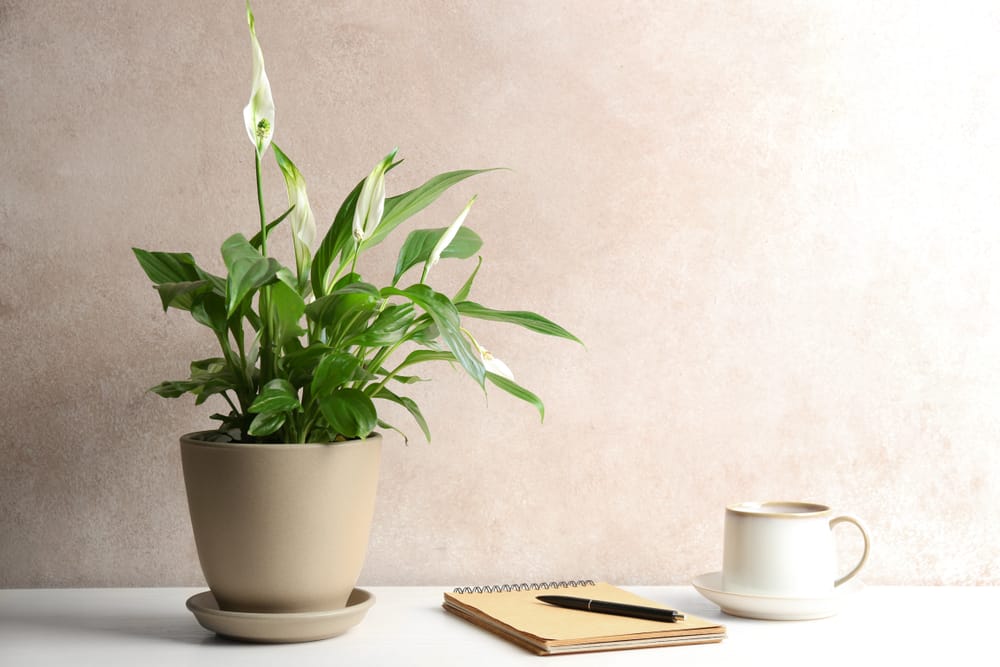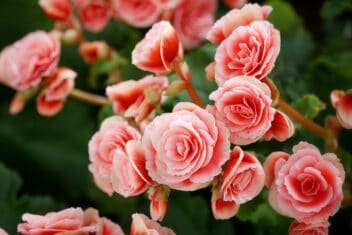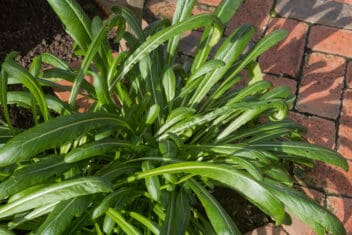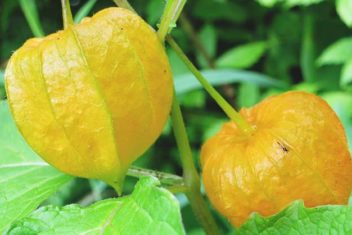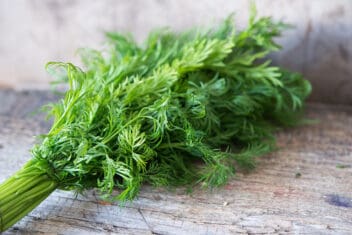Is there an office in the land where someone doesn’t have peace lilies growing in a pot on a desk? Peace lilies are a staple indoor plant that are popular in workplaces as well as homes.
Being reasonably low maintenance, peace lilies are the perfect choice because they aren’t too fussy and won’t die on you if you don’t pay attention to them every day.
Want to know another reason why they’re perfect for the office environment? They don’t need a lot of light, so they are fine in a slightly darker workplace or a shady corner of the home.
What is a Peace Lily?
Like many plants, peace lily (Spathiphyllum spp.) has a somewhat misleading name. It isn’t actually a lily, but is an arum. They share the distinctive look of a peace lily with arrow-shaped leaves and a broad spathe or flower.
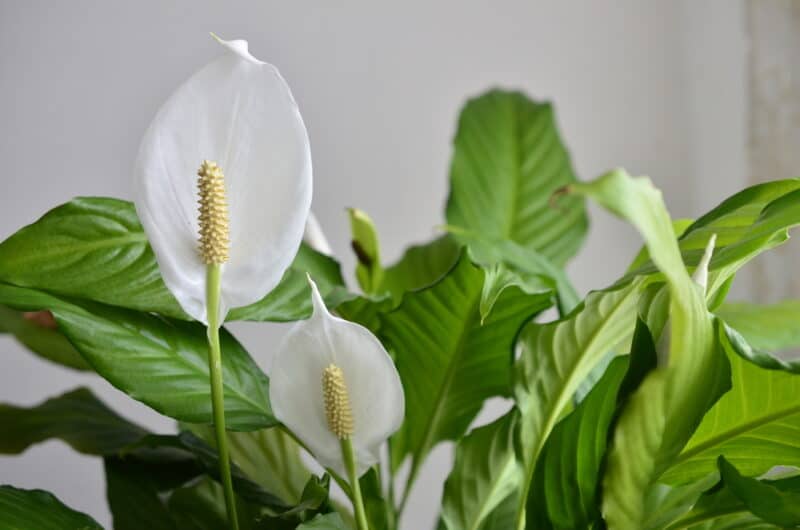
They are in the same family as dumb cane (dieffenbachia) and Swiss cheese plant (monstera).
Peace lily is a tropical evergreen that can be found on the forest floor of their natural environment. They are native to Central America and thrive on the humidity and dappled sunlight filtering through a forest canopy.
Peace lily received its common name because the beautiful white “flower” resembles a white flag, an internationally recognized symbol of peace. Its scientific name Spathiphyllum is from the Greek words spath for spoon and phyl for leaf, a reference to the spoon-shaped leaves.
Best Species and Cultivars of Peace Lily
Being a very popular plant, peace lilies have been hybridized extensively, so there will always be one to suit every taste.
Power Petite
Spathiphyllum ‘Power Petite’ is a hybrid that grows to about 15 inches tall, so is perfect for the office or smaller space at home. The leaves are a glossy, rich, dark green.
Mojo Lime
Cool in name and appearance, ‘Mojo Lime’ is a medium-sized plant at about 18 inches tall and has bright, lime green leaves. It has a well-earned reputation as a reliable bloomer.
Starlight
‘Starlight’ grows a bit larger than many other hybrids, topping out at about 24 inches. This is a prolific bloomer and even in an eight-inch pot can have up to 25 flowers at a time.
Sensation
‘Sensation’ is the largest cultivar of peace lily, growing up to six feet tall outdoors, though it rarely grows that large inside. It can also have a significant spread. Each leaf can be up to 20 inches long and the size, combined with its deeply-ribbed foliage, makes a striking statement.
Golden Delicious
This hybrid is fairly new on the scene. When it produces new growth, it emerges as a golden-green color that makes it stand out among peace lilies. Don’t eat it, though. Peace lilies contain calcium oxalate, which can be mildly toxic.
Mauna Loa Supreme
‘Mauna Loa Supreme’ is a common hybrid that you often see in stores. It can grow up to four feet tall with nine-inch-long leaves.
How to Plant Peace Lily
Peace lilies love a humid, shady environment, which is why a bathroom is a popular choice. But you can keep them just about anywhere, provided they are out of direct light and extreme heat or cold.
Shelter the plant from cold drafts and direct sunlight. Bright indirect light is best. Try to place your plant away from heat sources like heaters or fireplaces. Keep them away from doors or poorly-insulated windows that allow winds or cool air to enter the room.
Peace lilies like temperatures between 68ºF and 85ºF. You can allow temperatures to drop at night by about 10ºF, but try to keep the temperatures in your home consistent.
Peace lilies don’t like pots that are too much bigger than their root ball. Choose a container that is no more than 1/3 bigger than the root ball. Use a good quality potting mix and if you can, use a mix especially for indoor plants.
In USDA Growing Zones 10-12, you can grow peace lilies outside. Choose a sheltered spot in dappled sunlight. Make sure the soil remains consistently moist, but not soaking. The roots should never be sitting in pools of water.
Planting in Water
You can plant a peace lily in water and it will be quite happy if you follow a couple of rules.
Keep the base of the plant suspended slightly above the water to avoid rot setting in. You can use stones in the container to keep the base out of the water, or create a sort of shelf using sticks. Some stores sell peace lilies in containers with built-in supports to keep the plant above water.
All of these options allow the roots to grow into the water while keeping the base of the plant out, which is key.
Peace lilies that are grown like this develop special roots to get nutrients and will generally live shorter lives than ones in soil.
Propagating Peace Lily by Division
Propagating a peace lily is done by way of division. Cuttings won’t take and you’ll waste what you cut off. The good news is propagating by division is easy and rarely fails.
- Carefully remove the peace lily from its pot.
- You can break the individual plants apart or simply pull apart half the root ball to make two plants.
- If the peace lily was root bound, use a serrated knife to separate the roots. Start at the bottom of the rot ball and work up to toward the plant to divide.
- Replant each new plant in a pot slightly bigger than the root ball.
- The level of the soil should for the new plant should be at the same level as the old plant.
- Water well and place in indirect sunlight.
When you split and replant peace lilies, you may see quite serious wilting of the new plants. This is temporary and over a couple of days, the plant will recover and look like new.
Caring for Peace Lily

Peace lilies don’t need a lot of feeding, so in late spring, start providing fertilizer every six weeks or so until mid-fall. Use a plant food specific to indoor plants.
Peace lilies are good at letting you know if they need food, so just make sure the plant looks healthy and is growing well. If the plant looks tired or weak, give it a little more food, following the instructions of your particular fertilizer.
Consistent watering is a must for peace lilies. The soil must be kept moist, but not soaking. A lack of water will only be tolerated for a short period before the plant shows distress through wilting and browning of the leaves.
The white flower of the peace lily is actually a white leaf that surrounds a cluster of very small flowers on a stalk. Eventually, the white leaf and cluster of flowers will droop because they’re spent.
Cut the stalk of this spent flower as close to the soil surface as you can. This allows another one to grow. A stalk that produces a flower will only produce one, so cutting it off is necessary.
Peace lilies love humidity so mist the leaves or place the container on a tray of gravel or stones and keep them wet. You can also group plants to increase the relative humidity of the air around the plants.
Companion Planting for Peace Lily
If you like grouping your houseplants to create a more striking display, peace lilies work well as a centerpiece. Peace lily is a fairly forgiving plant, but you should try to plant it with species that have similar light and water requirements.
- Philodendron
- Scheffler
- Dracaena
- Coleus
Common Problems and Solutions for Growing Peace Lily
As we said, peace lilies are fairly easygoing, particularly if you’re growing them in the conditions they prefer. But, as with all plants, you might run into problems. Here’s what to watch for and how to deal.
Leaf Tips Turn Brown
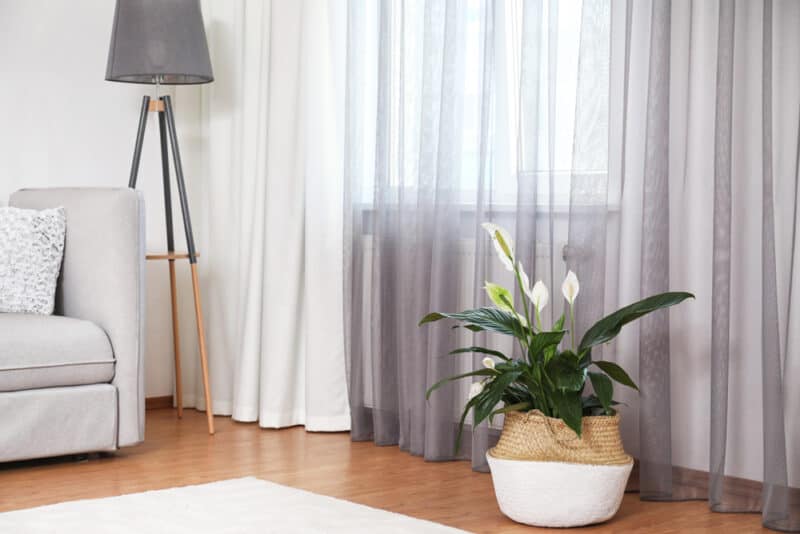
This is usually caused by excessive light, so find a location that provides indirect, rather than direct sunlight. Brown leaf tips can also be caused by a lack of water or insufficient humidity.
Over-fertilizing peace lily can also cause brown leaf tips.
Yellow Leaves
This is usually caused by either too much water or not enough. Keep the soil moist but not soggy and you shouldn’t go wrong. Yellowing might also be a sign of underfeeding. Try testing your soil and address the deficiency accordingly.
No Blooms
Although peace lilies are fine in low-light environments, a lack of blooms usually means there is not enough light. Move the plant to an area where there is more indirect light.
Root Rot
If your peace lily has yellowing leaves and wilting, it may have root rot. This is often caused by overwatering and allowing the plant to sit in soaking soil, especially if there is inadequate drainage.
It’s also caused by the fungus Cylindrocladium spathiphylli and the water mold Pythium spp.
Thankfully, peace lilies are usually easily saved if you get them in time. Remove the plant from its pot and clean the roots off by removing any decaying or slimy roots.
Repot in fresh, healthy potting mix, but make sure you sterilize the pot as well. Treat the soil with a copper spray.
Leaf Blight
Signs of leaf blight on peace lilies are the edges or centers of the leaves have brown or black dead spots. As the issue gets worse, the lesions become bigger and spread.
The best way to fight this is to repot the plant in a sterilized pot with fresh potting mix. Remove the infected foliage first and throw them in the garbage. Don’t compost infected leaves.
Spider Mites
Spider mites can be a problem on all houseplants and peace lily is no different. They live off the sap of the plant and can cover it in ugly webbing.
That webbing, along with little brown dots of feces and molted mite bodies are the first signs of spider mites that most people notice.
Spray the leaves with a misting bottle, or wipe them with a damp cloth if the spider mite numbers are small.
For larger infestations, use an insecticidal soap.
Aphids
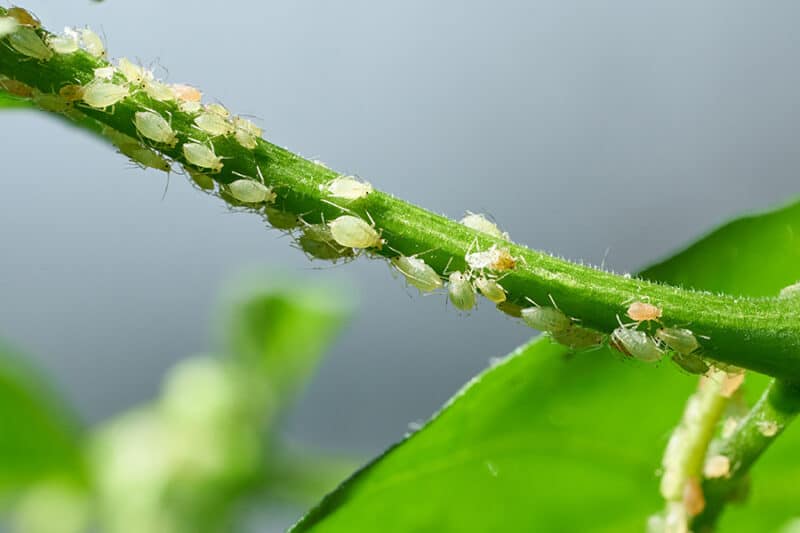
If your peace lily is looking a little worse for wear and gets a sticky slime forming on the foliage, it may be aphids. Use an insecticidal soap or an oil based treatment like neem oil. Our guide to these little sap-suckers has more info.
Mealy Bugs
You will see a mass of cottony appearance between the leaves and stems. Dip a cotton swab in rubbing alcohol and wipe the insects. This removes their protective coating and they will die.
Tips for Growing Peace Lilies Well
Inside
- Provide indirect light only.
- Water well, but don’t soak the soil.
- Ensure the pot drains well.
- Don’t use a pot that is bigger than 1/3 of the root ball.
- Rain water is better than tap water containing chemicals.
Outside
- Position should be sheltered from strong winds and provide dappled sunlight only.
- Don’t allow water to pool, especially after rain.
- If your area has frosts, plant in a container that you can move inside in the winter.
